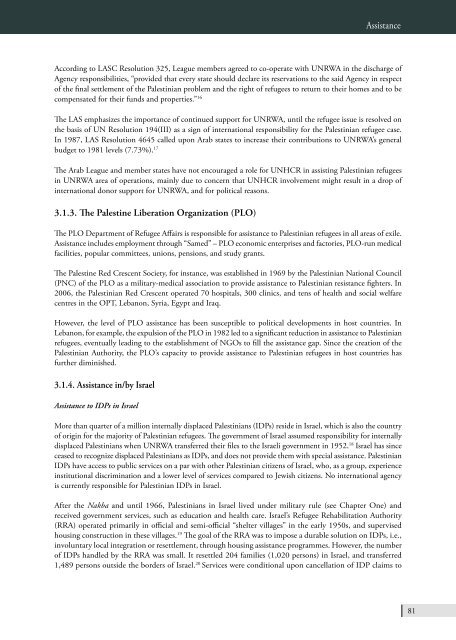BADIL Resource Center for Palestinian Residency and Refugee
BADIL Resource Center for Palestinian Residency and Refugee
BADIL Resource Center for Palestinian Residency and Refugee
Create successful ePaper yourself
Turn your PDF publications into a flip-book with our unique Google optimized e-Paper software.
Assistance<br />
According to LASC Resolution 325, League members agreed to co-operate with UNRWA in the discharge of<br />
Agency responsibilities, “provided that every state should declare its reservations to the said Agency in respect<br />
of the final settlement of the <strong>Palestinian</strong> problem <strong>and</strong> the right of refugees to return to their homes <strong>and</strong> to be<br />
compensated <strong>for</strong> their funds <strong>and</strong> properties.” 16<br />
The LAS emphasizes the importance of continued support <strong>for</strong> UNRWA, until the refugee issue is resolved on<br />
the basis of UN Resolution 194(III) as a sign of international responsibility <strong>for</strong> the <strong>Palestinian</strong> refugee case.<br />
In 1987, LAS Resolution 4645 called upon Arab states to increase their contributions to UNRWA’s general<br />
budget to 1981 levels (7.73%). 17<br />
The Arab League <strong>and</strong> member states have not encouraged a role <strong>for</strong> UNHCR in assisting <strong>Palestinian</strong> refugees<br />
in UNRWA area of operations, mainly due to concern that UNHCR involvement might result in a drop of<br />
international donor support <strong>for</strong> UNRWA, <strong>and</strong> <strong>for</strong> political reasons.<br />
3.1.3. The Palestine Liberation Organization (PLO)<br />
The PLO Department of <strong>Refugee</strong> Affairs is responsible <strong>for</strong> assistance to <strong>Palestinian</strong> refugees in all areas of exile.<br />
Assistance includes employment through “Samed” – PLO economic enterprises <strong>and</strong> factories, PLO-run medical<br />
facilities, popular committees, unions, pensions, <strong>and</strong> study grants.<br />
The Palestine Red Crescent Society, <strong>for</strong> instance, was established in 1969 by the <strong>Palestinian</strong> National Council<br />
(PNC) of the PLO as a military-medical association to provide assistance to <strong>Palestinian</strong> resistance fighters. In<br />
2006, the <strong>Palestinian</strong> Red Crescent operated 70 hospitals, 300 clinics, <strong>and</strong> tens of health <strong>and</strong> social welfare<br />
centres in the OPT, Lebanon, Syria, Egypt <strong>and</strong> Iraq.<br />
However, the level of PLO assistance has been susceptible to political developments in host countries. In<br />
Lebanon, <strong>for</strong> example, the expulsion of the PLO in 1982 led to a significant reduction in assistance to <strong>Palestinian</strong><br />
refugees, eventually leading to the establishment of NGOs to fill the assistance gap. Since the creation of the<br />
<strong>Palestinian</strong> Authority, the PLO’s capacity to provide assistance to <strong>Palestinian</strong> refugees in host countries has<br />
further diminished.<br />
3.1.4. Assistance in/by Israel<br />
Assistance to IDPs in Israel<br />
More than quarter of a million internally displaced <strong>Palestinian</strong>s (IDPs) reside in Israel, which is also the country<br />
of origin <strong>for</strong> the majority of <strong>Palestinian</strong> refugees. The government of Israel assumed responsibility <strong>for</strong> internally<br />
displaced <strong>Palestinian</strong>s when UNRWA transferred their files to the Israeli government in 1952. 18 Israel has since<br />
ceased to recognize displaced <strong>Palestinian</strong>s as IDPs, <strong>and</strong> does not provide them with special assistance. <strong>Palestinian</strong><br />
IDPs have access to public services on a par with other <strong>Palestinian</strong> citizens of Israel, who, as a group, experience<br />
institutional discrimination <strong>and</strong> a lower level of services compared to Jewish citizens. No international agency<br />
is currently responsible <strong>for</strong> <strong>Palestinian</strong> IDPs in Israel.<br />
After the Nakba <strong>and</strong> until 1966, <strong>Palestinian</strong>s in Israel lived under military rule (see Chapter One) <strong>and</strong><br />
received government services, such as education <strong>and</strong> health care. Israel’s <strong>Refugee</strong> Rehabilitation Authority<br />
(RRA) operated primarily in official <strong>and</strong> semi-official “shelter villages” in the early 1950s, <strong>and</strong> supervised<br />
housing construction in these villages. 19 The goal of the RRA was to impose a durable solution on IDPs, i.e.,<br />
involuntary local integration or resettlement, through housing assistance programmes. However, the number<br />
of IDPs h<strong>and</strong>led by the RRA was small. It resettled 204 families (1,020 persons) in Israel, <strong>and</strong> transferred<br />
1,489 persons outside the borders of Israel. 20 Services were conditional upon cancellation of IDP claims to<br />
81

















